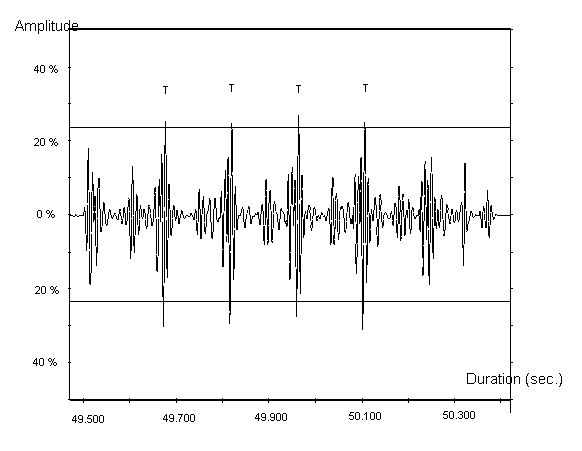
Telemetric measurement of heartbeat sound during behavioural testing in laying hens
B.M. Hjarvard1, F.B.L. Mortensen1, O.N. Larsen1 and J.B. Kjaer2
1Centre
for Sound Communication, Institute of Biology, University of Southern Denmark,
Odense, Denmark
2Department of Animal Health and Welfare, Danish Institute of Agricultural
Sciences, Research Centre Foulum, Tjele, Denmark
As part of a study on feather pecking behaviour in laying hens we wanted to evaluate the effects of genetic selection for high and low levels of feather pecking by (1) a characterisation at the behavioural level and (2) a relationship with a relevant physiological variable. Therefore, we developed a simple non-invasive telemetric method to monitor the heartbeat with a microphone of freely moving hens.
Birds originated from two batches of the S3 generation of lines selected for high (HL, n=24) or low (LL, n=24) levels of feather pecking [1]. Behavioural testing included Tonic Immobility (quantified by number of inductions and duration) and Open Field responses (recorded on videotape and concurrently coded for latency scores and locomotor activity during 10 minutes observation periods). The heart rate recording equipment consisted of a microphone, a custom-built amplifier, an UHF FM radio-transmitter with short antenna, and a battery package all mounted in a nylon harness fitting the thorax of the bird. At a distance of 3-10 m from the experimental bird signals were received on a radio-receiver coupled to a filter, an oscilloscope, and a DAT recorder. The microphone (Knowles 2833) was fitted with a conical metal collar and coupled to the skin above the left m. pectoralis by harness pressure. Signals were high-pass filtered (25 Hz), amplified by a factor 100, and transmitted at 418 MHz (Radiometrix TXM-418-A) to the receiver (Radiometrix SILRX-418-A). Here signals were band-pass filtered (100-150 Hz) by custom-built four-poled active filters and monitored on a Philips digital oscilloscope, while being recorded on DAT (Sony TCD-D10 PRO). The processing of heartbeat recordings was performed off-line with sound analysis software (BatSound Pro 3.0, Pettersson Elektronik AB) after digitising (Soundblaster) the DAT recordings. The heartbeat rate was quantified by manually adjusting measuring cursors and using the pulse interval analysis feature to calculate an average value of heartbeat rate every 5 seconds throughout the test periods.

Figure 1. Heart beat signals with measuremtnes identified. Heat rates were calculated in beats per min based on the duration recorded from the peak of one T wave to the peak of the next wave.
Heartbeats were easily distinguishable from infrequently occurring movement artefacts and easily quantifiable. We only quantified heart rate but the clear-cut heartbeat sounds (Figure 1) have great potential for further analysis. The two lines of hens differed significantly in heartbeat rate during both types of behavioural tests, although there were no significant differences between lines at the behavioural level in terms of duration of Tonic Immobility and general Open Field activity scores. This simple method has great potential for providing a physiological correlate in future behavioural studies of feather pecking in laying hens.
Poster presented at Measuring Behavior 2000, 3rd International Conference on Methods and Techniques in Behavioral Research, 15-18 August 2000, Nijmegen, The Netherlands